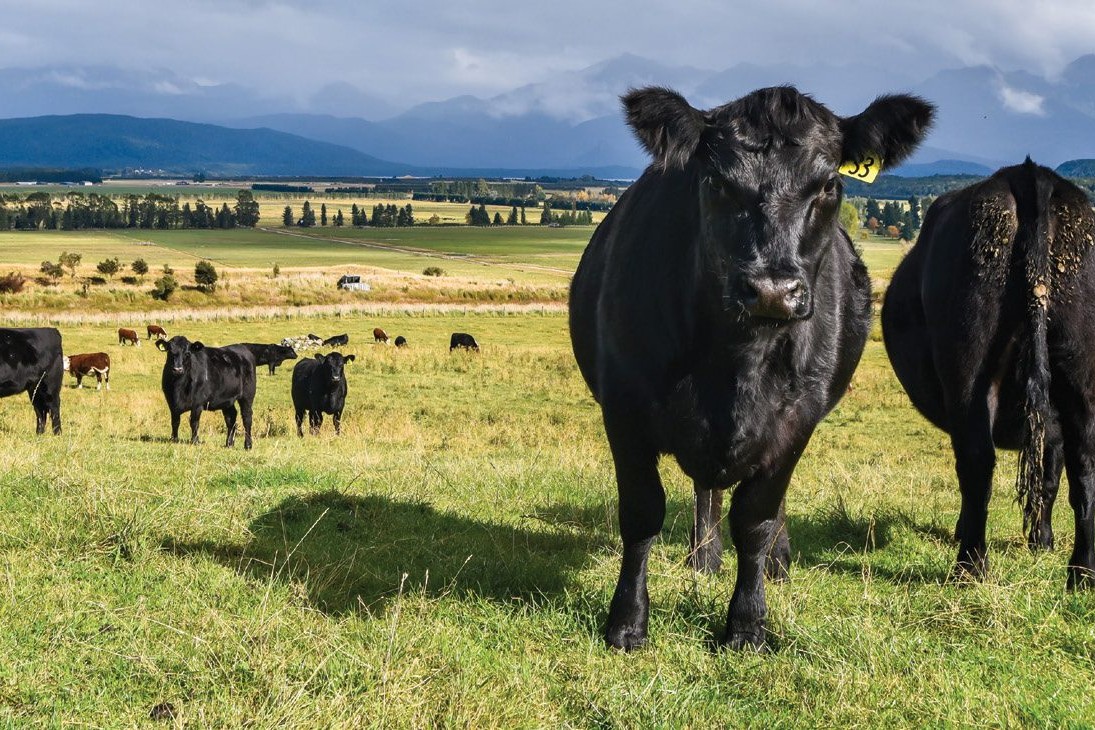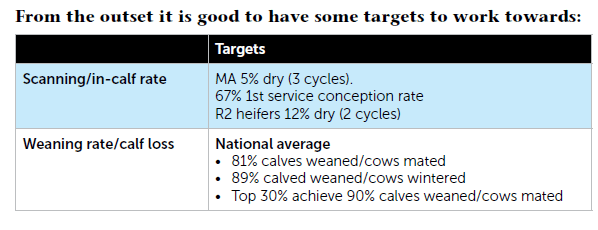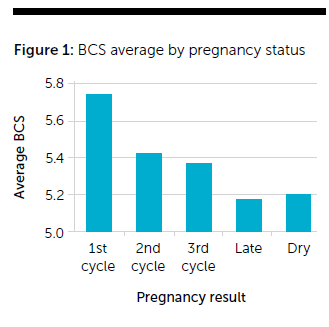The beef cow fertility equation
Calving rate is critical in beef herds, North Otago Vet Dave Robertson writes.

Calving rate is critical in beef herds, North Otago Vet Dave Robertson writes.
The calving rate of beef herds is not the main thing… it is everything.
Before worrying about horns, colours and meat traits make sure the herd gets in calf at the right time.
What is the right time? What are the key factors that drive pregnancy rates?
What monitoring and safe-guards can herd managers take to ensure good reproductive rates are maintained?

Feeding and BCS
Cows ideally need to be opened up to full feeding levels two to four months after calving. So matching calving date grass growth is a critical aspect. The consequences of mating too early are:
- Proportionally fewer get in-calf in the first cycle as less are ready to conceive. Those that do get in-calf early have a higher feed demand before a surplus arrives. This puts pressure on the whole herd at a point when the herd needs to be “on the bounce” condition wise.
- The risk of metabolic issues (such as magnesium staggers) around calving time increases if cows cannot access enough feed through the day. Particularly if set stocked with higher sheep ratios. To calve early, more conserved feed is required.
- Bulls can have more chances to sustain injuries just by being out longer and having to work harder for the full mating period to achieve pregnancies.
- Heifers mated too early will not be cycling at sufficient levels in the herd to achieve a tight two-cycle mating.
I will not put specific dates to work from because New Zealand has many different climates and grass growth conditions. Also the North Island model seems to be one where cows can routinely lose weight over winter, but with explosive spring growth can pile it back on over mating. The South Island systems often perform better when cow condition is maintained over winter and a buffer is in place for variable spring growth.
Discussions about cow condition are easier from my perspective as an adviser if you have some data points. Routine body condition score (BCS) monitoring at pregnancy testing has highlighted trends of when and if cows get in-calf based on BCS. Figure 1 on page 56 shows a recurring but subtle trend we pick up from routine BCS and pregnancy rate analysis.
In North Otago this season we have had very good growth from November to February which has meant cows have grown calves out well and generally resumed cycling early.

Genetics
Traditionally, beef producers improve their herds by selecting for growth of progeny and visual size. Growth is an easy and economical trait to measure and is moderately heritable.
Selection for growth traits has resulted in faster growing cattle, however it has also resulted in the introduction of some correlated undesirable traits such as increased birth weights. These have led to calving difficulties, delayed sexual maturity and increased herd maintenance requirements associated with greater feed costs of larger animals (B+LNZ Guide to New Zealand Cattle Farming May 2017).
Defining your breeding objective and the type of cow that suits your country and wintering system is a key. Writing this down and sticking to it when selecting bulls will give you clarity.
Calving ease and dystocia
The incidence of calving difficulty varies and is probably responsible for up to two thirds of calf deaths in beef cow herds. Although this has not been diagnosed as the cause of calf losses on a lot of farms, it still needs consideration.
The average calf mortality in herds is 0-15%. It is higher in younger cattle. Dystocia is very influenced by gestation length and calf birth weight, but pelvis shape of the heifer and shape of the calf are also important.
National averages are for two-year heifers average 7% assisted and three-year heifer average is 1.7% assisted.
Calving ease breeding values: There are two calving ease EBVs:
- Calving ease maternal (daughter) is the bull’s EBV associated with his daughter’s ability to calve.
- Calving ease direct EBV is an indication of the bull’s progeny’s ease of calving i.e. influenced by size and shape etc of the calf. Components include calving ease score, gestation length and birth weight.
A larger positive value for both maternal and direct is a desirable selection option. Birth weight EBV is commonly used as a proxy for calving ease because it is easier to measure. However, it does not predict calving ease as accurately as calving ease direct EBV.
The New Zealand Angus self-replacing index ranks bulls on their progeny’s ability to generate profit per cow mated in a self-replacing herd in which some females are retained for breeding and surplus females, along with all males, are slaughtered. The main drivers of profit included in the index in order of economic importance are; direct and maternal calving ease, growth, meat yield, cow survival, finishing ability, fertility and cow efficiency. Selection on this Index is expected to favour production in a cow herd with excellent reproductive efficiency, rearing progeny with moderate-to-high growth rates and high-yielding carcases.
Table 1 covers off the seven main factors that drive beef herd reproduction. Going through this list and picking out what you can monitor and what you can control will invariably lead to achieving a good result. In my experience dry cows result from more than one factor, so just to pick out BVD (say) as the main cause without addressing bull soundness or cow condition will not lead to an improvement next year.
We can’t always get them all in-calf but if herd managers tick off the following basics good calving rates will generally follow:
- Monitor BCS pre-mating and prior to winter to help plan key periods of feeding. Key points: April 1, how much can they lose. November 1, how much do they need to gain.
- Age pregnancy test. Record cycle groups and permanently identify later calvers.
- Get a BVD plan to either eradicate or control with vaccine.
- Ensure adequate mineral levels and young stock animal health
- Develop female-focused breeding objective.
- Test bulls for mating ability annually, 45% of unsound bulls go out for another year if not service tested.

Dave Robertson is a vet with the Veterinary Centre Oamaru.




